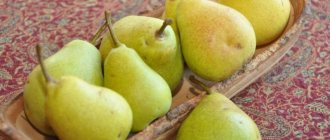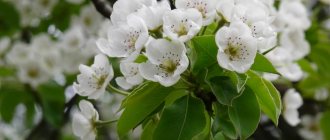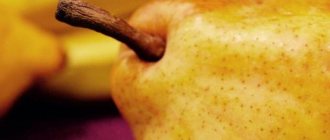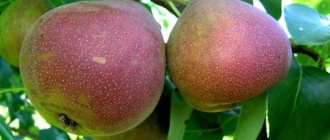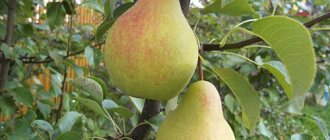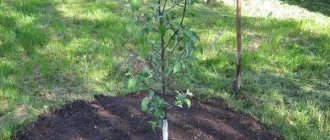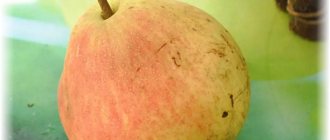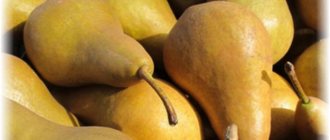History of selection
The creation of frost-resistant hybrids for Siberia is the general goal of the work of the NIISS team named after. M. Lisavenko , which he has been involved in since 1973. Now branches of the research institute and experimental gardens are located in three regions: Tomsk region, Barnaul, Altai Republic.
Mikhail Afanasyevich Lisavenko, who devoted himself to gardening in Siberia and created more than 128 varieties of fruit and berry crops, is no longer alive, but breeding work continues among new products - winter-hardy pear varieties named after the Old Slavic gods: “Svarog”, “Perun”, “Veles”, “Lel” ", "Kupava".
For our pre-Christian ancestors, the father of all things was Svarog - the earthly incarnation of the Family. What meaning does this name of an interspecific hybrid carry?
Advantages:
- undeniable resistance to the cold winters of Siberia (down to -30°C);
- fruit ripening before the first frost (September-October);
- regularity of average harvest volume;
- good presentation;
- shelf life (up to 3 months);
- value of consumer qualities;
- raw material importance in processing;
- resistance to pathogenic fungi and bacteria.
The following pear varieties have good winter hardiness: Severyanka, Bere Russkaya, Yakovlevskaya, Uralochka and Chizhovskaya.
Flaws:
- fruit size (below average size);
- self-sterility and dependence on the pollinator;
- crown density;
- susceptibility to the effects of drought.
Help: The pear tree is very light-loving, but suffers from drought; its frost resistance is clearly inferior to cherry and apple varieties popular in the same regions.
Pear varietal characteristics
The pear variety with the unusual name “Svarog” forms a medium-sized tree with a rounded and thickened crown. The bark is grayish-brownish, flaky. The shoots are characterized by slight arching, dark reddish-brown color and pronounced pubescence at the ends.
The leaves are small, elliptical, with a helical tip, light green in color. Wrinkling is pronounced, and slight pubescence is also present.
The fruits weigh 77-79 g. They have a cone- or pear-shaped shape. The skin is not rough, but without a pronounced shine. The main coloration at the removable maturity stage is green. At the stage of consumer maturity the color is yellow. The integumentary coloration is blurred or striped, reddish in color, with a characteristic slight blush. The subcutaneous dots are smallish, greenish in color, and pronounced. The ripe pulp is cream colored, very tender and juicy. The taste is sweet and sour.
Indicators of the content of basic elements in ripe fruits:
- total sugar content – no more than 9.5%;
- titratable acid content – slightly less than 0.5%;
- tannin content – about 170 mg;
- ascorbic acid content – just over 9 mg.
The benefits and harms of champagne for the health of the body
The ripeness of the harvest occurs in the last ten days of September. The collected fruits enter the period of consumer ripeness in the first ten days of October.
The shelf life of the crop at room temperature is at least two to three weeks. When stored in the refrigerator, the marketability and taste of pears are preserved until mid-January.
Species features
Pear as a plant is found in nature in the form of a bush and tree.
Historical areas where pears of different varieties grow: Persia, Southern Europe, the Caucasus, Pamir, Far East and distant Tasmania.
All these types can be divided according to ripening periods into:
- early (early autumn for Siberia);
- autumn (late autumn for Siberia);
- winter (not typical for Siberia).
- Common pear - a wild form of fruit tree, differing in morphological characteristics.Depending on where they grow, 60 species are classified, here are a few of them:
- Russian pear - characterized by increased drought resistance and not very high winter hardiness: growing area - Central Russia;
snow pear - a promising rootstock from the mountainous regions of the Caucasus and Central Asia;
- Caucasian pear - grows at an altitude of one and a half thousand meters above ocean level; effective in crossing with cultivated varieties to obtain high yields;
- Ussuri pear is a Far Eastern endemic with a very high level of winter hardiness (up to -50°C);
- domestic pear - viable local varieties used as a universal rootstock;
- “Kayon” pear is a type of pear from the Western Pamirs with an atypical shape of triangular fruits, which acquire consumer value only after two weeks of aging in the ground, being buried;
- Chinese pear is an oriental type of crop, distinguished by its juiciness; an ungrafted tree is characterized by sour fruits.
- Garden pear is a tree (from 5 to 25 meters in height), there are 5000 varieties with an average ripening period of August-October.
Household and cider varieties are used for industrial processing, while dessert varieties are supplied to the consumer's table.
Interesting: If in our country preference was originally given to the apple tree, then in Europe - to the pear. From there came the exquisite recipes for desserts made from pears, the idea of “pear honey”; in Belgium, already in the 18th century, the beginning of the selection of this garden crop was laid.
How to plant a tree on your property correctly
In order for the landing to be successful, it must be carried out correctly - and you need to pay attention to the following points:
- choosing a place where the fruit tree will grow;
- selection of high-quality and suitable seedlings.
Site selection and land preparation
Secluded and sheltered areas of the garden with sufficient sunlight are suitable for growing pears. It is optimal to place trees close to the house or utility room, the walls of which can shelter the tree from strong gusts of wind.
When do you need to revive roses in a vase with water and how to save flowers if they begin to fade?
At the planting site, groundwater should not be closer than 2–3 m to the surface, since the soil may be too wet, which can negatively affect the root system and even lead to its rotting. Svarog can be grown in any region, but it is worth noting that this variety is successfully cultivated in the northern regions.
How to choose the right seedlings
The choice of planting material is an important point, during which it is necessary to pay attention to the following qualities of seedlings:
- Size of the root system - it should be dense and well developed, which will contribute to good growth of the tree.
- Height - the optimal size is 70 cm or more.
- Age: must be no more than 2 years old.
- When examined, its surface should be free of damage, deformation, and stains that may indicate damage by pests or diseases.
How to prepare and plant seedlings on the site
Before proceeding directly to the planting process, it is recommended to prepare the seedlings, which involves:
- removal of damaged areas of rhizome;
- soaking them in mash made with heteroauxin.
Next you should start preparing the planting hole. This process must be taken care of in advance, several weeks before planting the seedling, which will help compact the top layer of soil.
A hole is dug about 80–100 cm in diameter and 60–80 cm deep. Organic fertilizers are added to the soil at the rate of about 8 kg per tree.
Agricultural technology for planting pears:
- In the planting hole, it is necessary to form an earthen mound from prepared and fertilized soil.
- A seedling is placed on an earthen embankment and its rhizome is straightened.
- A peg is driven into the planting hole, which will serve as a support for the tree. Its height should be about 40 cm.
- The root collar should rise 6 cm above ground level.
- The rhizome is covered with earth, which is then lightly compacted.
- It is necessary to organize a hole for watering (40 cm in diameter) - this will allow watering to be done in a more gentle way for the tree. After planting, 4–5 buckets of water are poured into it.
- After watering, it is necessary to fertilize the seedling with humus and mulch the planting site with peat to retain moisture.
Photo
Family inheritance
The “Svarog” variety was created by crossing the Ussuri pear, which is characterized by winter hardiness of late ripening .
What parents gave to the new hybrid form:
- from the “Bere Bosk” variety - resistance to scab and other fungal diseases is inherited; the commercial attractiveness of the fruits and their unique taste; increase in yield as the plant matures; undemanding to soil composition with sufficient watering;
- from the Ussuri pear - the ability to vary in the process of clonal selection; exceptional frost resistance; drought tolerance; undemanding to soil composition.
True, the fruits of this decorative variety are unpleasant in taste and small in size, and you will have to wait 20 years for them after planting the seedling.
Help: The abundance of fiber in pear fruits helps remove harmful cholesterol from the human body. The astringent taste of most domestic varieties is due to tannins - natural means of preventing salt deposits. Taste buds easily identify stony cells in the pear pulp - its supporting tissue. In wild varieties, the presence of these cells is more pronounced, which creates a crunch when biting the fruit.
Rules for caring for Svarog pear
Subsequent care for the Svarog variety consists of the following activities.
- Watering. Plants especially need it in dry years. Watering is best done by sprinkling or in small trenches dug around the trunk.
- Loosening and mulching the root circle will provide access to oxygen and moisture to the root system.
- Fertilizing with organic fertilizers begins in the third year of the plant’s life. They are performed mainly in the spring.
- Lightening and sanitary pruning of branches is most often carried out in the fall after harvesting or in early spring before the sap begins to flow. It is advisable to treat the cuts with garden varnish.
- In winter, make sure that the root circle is always covered with snow.
Description of the variety Svarog
Since 1996, the Svarog variety has been included in the State Register as recommended for cultivation in Western and Eastern Siberia and the Volga-Vyatka region.
In these regions, the following pear varieties do well: Hera, Cathedral, Krasnobokaya, Elena and Vernaya.
This is a medium-sized plant with a lush, rounded crown and the following morphological characteristics:
- trunk is covered with grey-brown, slightly flaky bark, with well-formed skeletal branches;
- young shoots are covered with dark, red-brown skin, with edges at the ends; shoots are curved in an arc;
- buds are of two types: generative (where flowers are formed) and vegetative (for laying leaves); the former are larger and rounder, the latter are sharper and smaller;
- leaves of a peculiar elliptical shape with a screw-twisted tip; small, light green, with a wrinkled plate and light edge; at the end of the growing season they fall off;
Interesting: Pear trees, depending on the place of growth and variety, vary greatly in leaf shape: willow-leaved, pucker-leaved, and even with a leaf similar to birch.
- flowers are self-sterile, with a fused ovary and without anthers; medium size, 5 petals, flowers collected in umbrella inflorescences;
Important: For pollination of this variety, “Povislaya” and “Vekovaya” pears planted nearby are effective. Without pollination, a few fruits may still appear on a pear tree, but they will look defective and will not produce seeds.
- fruits weighing up to 80 grams have a round shape, rough skin without shine, by the time of full ripening they are yellow in color and have a blurred blush on the sunny side; stony cells are clearly visible under the skin in the form of greenish dots; large dark seeds are enclosed in closed chambers; medium-sized stalk;
- the pulp is juicy, tender, cream-colored ; taste characteristics are determined by 4.5 points ; the composition of sugars and ascorbic acid is presented equally - 9.5%;
- The fruiting of the variety occurs in the 4th year ; the process is regular, the volume of fruits is moderate;
- Full ripening of the fruit ends by the beginning of October ;
- the average yield per tree in the Altai nursery is 19 kg ;
- high resistance to fungal infections;
- winter hardiness - exceptional.
The taste of pears of this variety largely depends on the temperature regime: in hot summers they are sweet, in rainy summers they are fresh and watery.
The following pears can boast of excellent taste: Cosmic, Mramornaya, Karataevskaya, Kupava and Krasulya.
Full ripening is manifested by the shedding of fruits. Pears collected before shedding have a reduced shelf life.
Watch a video about the Svarog pear variety.
Reviews from gardeners about the Svarog pear
Anna, 35 years old, Novosibirsk In our region, it is difficult to select varieties of fruit trees that will consistently produce crops. The Svarog variety is one of the few. I will say this, this is a modest worker of Siberia. Doesn't freeze. The fruits have time to ripen before the onset of cold weather. And most importantly, they are stored for a long time. Sometimes in December you can taste fresh and fragrant pears.
Svetlana, 50 years old, Vyatka The Svarog variety has been growing in our country for about 15 years. My father planted it. And not a single year were we left without a harvest. He may not be the richest, but he always bears fruit. Even when other varieties did not bear fruit. There is one minus and a very significant one. Abundant watering in hot summers. Otherwise, the pears become dry and tasteless.
Use of fruits
Absolutely everything in this fruit plant can be useful to a person:
- fruits - in the confectionery and canning industry (marmalade, marshmallows, candied fruits, juices, wine, cider, kvass, etc.);
- leaves - in the prevention and treatment of various diseases;
- wood - in furniture production, making models and molds, car finishing, to imitate valuable ebony wood;
- the plant itself is used in landscape design and for strengthening sandy slopes.
Interesting: The Swiss invented “Pear Honey”, which is obtained by condensing pear juice to the viscosity of honey. The concentrate has a thick, opaque, dark brown consistency of candied honey.
Agricultural technology
Pear variety Svarog - description of agricultural technology:
- For proper planting of pears, the choice of place is especially important: the warmest and most protected in the garden. The plant can be grown as a bush, on a wire base - a trellis, or in a wall planting - a fan palmette. The best time to plant pears is autumn.
- When choosing seedlings, you should give preference to those with a thicker root system, which guarantees rapid plant growth. Before planting, remove damaged roots and dip them in soil mash based on heteroauxin.
- In the prepared pit, a hill is formed from the added soil, on which the roots of the seedling are straightened. A support peg is driven in to which the tree trunk will be attached.
The root collar should be left above the ground (6cm).- The roots are covered with earth and gently pressed down. A hole with a diameter of 40 cm is formed, into which water is poured (4-5 buckets), humus is added and finally mulched with peat. After two weeks, watering can be repeated.
- Pruning is done for sanitary purposes (dried and broken branches), for crown formation and thinning.
- Fertilize annually with organic matter and phosphorus-potassium compounds .
Interesting: The pear is not a tropical fruit at all, just like the apple. But in equatorial latitudes there is a ficus pear with hanging roots that are many meters long.
Planting Svarog pear
Its further development and fruiting will depend on compliance with the rules for planting the Svarog pear. By choosing the right place to grow fruit trees, caring for them becomes much easier.
Deadlines
In the Northern regions and Siberia, Svarog pear seedlings are planted in the spring. The optimal time is the end of April or the first half of May. In regions with a mild climate, autumn planting is also possible.
Preparatory activities
When choosing a place to grow Svarog pears, choose a well-lit area. It is advisable for the trees to be in partial shade for part of the day. In this case, the root circle will not overheat, and the seedlings will not be in dire need of watering. Pears are planted on the south-eastern slopes of small hills, as well as on the south or west side of buildings or fences, which will serve as protection from cold winds.
Select areas with fertile soil. Svarog pears bear fruit well on black soil soils. But with careful attention to the trees, they will bear fruit on podzolic or meadow soils.
The holes for planting Svarog pear seedlings are prepared in advance. Dig holes 80 cm deep and 80-90 cm in diameter. The removed soil is mixed with compost or humus at the rate of 1-2 buckets per hole. When planting on podzolic soils, add wood ash or slaked lime to the mixture. Fill the holes approximately three-quarters full with the prepared mixture. Immediately install stakes for future supports. The holes are shed generously with water.
How to plant
Svarog pear seedlings are planted in holes, carefully straightening the roots, so that the root collar is 4-6 cm above the ground surface. The holes are covered with layers of soil. Each of them is well kneaded. Water generously again.
It is recommended to mulch the root circle with sawdust or peat. In the first year after planting, plants need abundant watering.
Diseases and pests
- From common plant aphids. A solution of Karbofos or Rovicura will help.
- From the weevil - polyphagous tubeweevil. For its laying, it curls leaves on young shoots. In the fight against it, collecting and burning affected leaves and spraying with a solution of “Nitrophen” (3%) are effective.
Bacteriosis . Damage by pathogenic bacteria spreads through the vascular system of the tree, capturing leaves, branches and, finally, the entire trunk. It is important to promptly remove infected branches to prevent the spread of the parasite. Trimming is done with a disinfected tool, and the trimmings are burned. If the plant is completely damaged, there is only one way out - uproot it.
Northern pear varieties are always a little exotic in your garden.
And the availability of this exotic became possible as a result of the continuous work of breeders and Altai fruit growers, among others.
Advantages and disadvantages
If you compare the autumn pear variety Svarog with more productive varieties, you can find many disadvantages in it:
- insufficiently large fruit size;
- the tendency of the crown to thicken and the need for frequent pruning;
- the trees are demanding of the soil (it should not be dry or excessively wet);
- satisfactory resistance to some pests;
- The self-fertility of the variety is only partial, which requires additional pollination.
The pear also has advantages. These include:
- good winter hardiness;
- immunity to fungal diseases;
- good presentation of ripe fruits;
- excellent taste;
- quite a long shelf life (refrigerated for 3 months);
- versatility of fruits (possibility of processing);
- their inclination to shedding, spoilage, and rotting.
As you can see, the variety still has more advantages than disadvantages, and many gardeners speak very highly of it. And to ensure that the harvest is always high, select good pollinators for the pear - they will not only increase productivity, but also improve the quality characteristics of the fruit.


